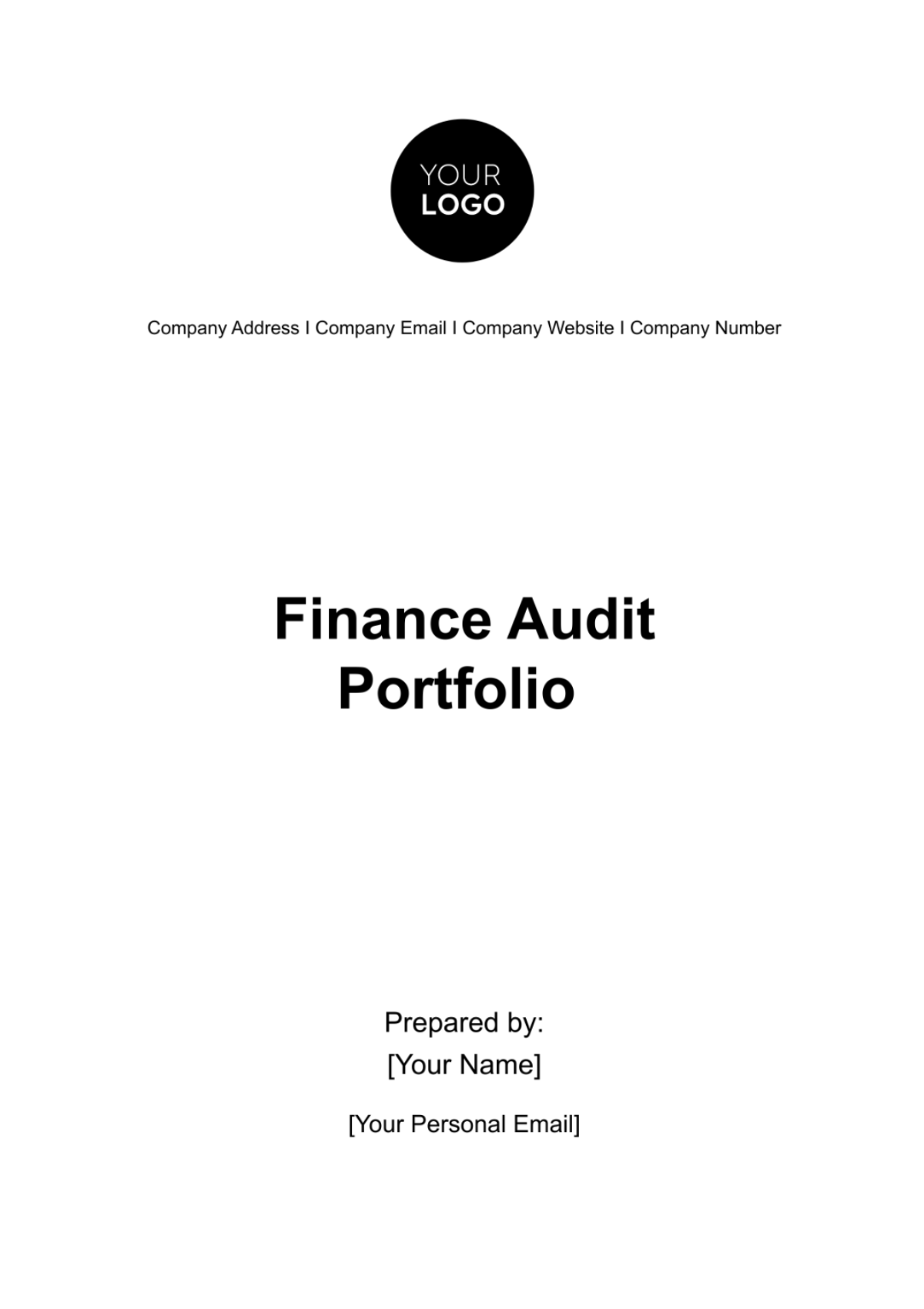Free Finance Audit Portfolio

Executive Summary
The Finance Audit for [Your Company Name] was conducted to evaluate the effectiveness and compliance of the finance department's processes and controls. The audit covered a period of 12 months, ending on December 31, 2023. Key areas examined included financial reporting, accounts payable and receivable, payroll processing, and internal controls. The audit methodology comprised a combination of document reviews, interviews with key personnel, and data analysis using advanced auditing tools. The findings indicate a generally strong compliance with financial regulations and internal policies, but also highlight areas needing improvement, particularly in the domains of payroll processing and internal fraud prevention.
Audit Objectives
Purpose
The primary goal of this audit was to ensure that the finance department's operations align with legal requirements, industry standards, and company policies. Specifically, the audit aimed to verify the accuracy of financial reporting, assess the efficiency and effectiveness of financial transactions processing, and evaluate the robustness of internal controls in mitigating financial risks.
Scope
The audit focused on the following key areas within the finance department:
Financial Reporting: Accuracy and timeliness of financial statements.
Accounts Payable: Vendor payment processes and controls.
Accounts Receivable: Revenue recognition and collection processes.
Payroll: Compliance with labor laws and accuracy of payroll calculations.
Internal Controls: Effectiveness of controls in preventing errors and fraud.
Audit Methodology
Approach
The audit of [Your Company Name]'s finance department was conducted with a comprehensive approach that combined theoretical frameworks and practical methods to ensure a thorough evaluation of financial processes and controls. The primary focus of the approach was to assess compliance with regulations, accuracy in financial reporting, and the effectiveness of internal controls.
Risk-Based Approach
The audit adopted a risk-based approach to prioritize areas of higher risk. This involved an initial assessment of the finance department's operations to identify potential vulnerabilities and areas of non-compliance. The risk assessment guided the allocation of audit resources to areas with the greatest impact on the organization's financial stability.
Sampling and Random Selection
To ensure a representative evaluation, both random and targeted sampling techniques were employed. Random sampling was used to select a subset of transactions, invoices, and financial records for examination. Additionally, targeted sampling focused on specific high-risk areas, such as procurement and payroll, to provide a deeper analysis of critical processes.
Tools and Techniques
The audit team utilized a variety of tools and techniques to gather data, assess controls, and identify potential issues.
Data Analytics
Data analytics played a pivotal role in the audit process. Advanced auditing software was employed to analyze vast volumes of financial data, enabling the identification of anomalies, trends, and irregularities. This approach allowed for a more efficient and comprehensive review of financial transactions.
Interviews
Structured interviews were conducted with key personnel within the finance department. These interviews provided valuable insights into the day-to-day operations, internal controls, and potential areas of concern. Personnel ranging from finance staff to management were interviewed to gather a 360-degree perspective.
Document Review
A thorough examination of financial records, policies, and procedures was carried out. This document review ensured that all processes were adequately documented and aligned with current regulations and industry best practices. Any discrepancies or gaps in documentation were noted for further investigation.
Risk Assessment
A comprehensive risk assessment was conducted to identify potential threats and vulnerabilities within the finance department. This included assessing risks related to financial transactions, data security, and compliance with external regulations. The results of this assessment guided the development of the audit plan and the allocation of audit resources.
Continuous Monitoring
Throughout the audit, a continuous monitoring process was implemented to track changes and developments in the finance department's operations. This allowed for real-time identification of emerging risks or issues that required immediate attention.
Findings and Analysis
This section presents a detailed analysis of the findings from the audit of [Your Company Name]'s finance department. The audit revealed various strengths and areas for improvement across different functions.
Compliance with Policies and Regulations
The audit showed a high level of compliance with most internal policies and external regulations. However, specific issues were identified in certain areas, as detailed below.
Table: Summary of Compliance Issues
Area Examined | Compliance Status | Comments |
Tax Reporting | Fully Compliant | All tax filings were accurate and timely. |
Payroll | Partially Compliant | Discrepancies found in overtime calculations. |
Procurement | Non-Compliant | Lapses in vendor validation process. |
Narrative Analysis
In the area of payroll, the audit uncovered inaccuracies in the calculation of overtime pay, impacting approximately 5% of the workforce. These inaccuracies stem from a misinterpretation of labor laws regarding overtime. In procurement, the audit found that the existing vendor validation process lacks sufficient checks to ensure compliance with company standards, resulting in a few instances of engaging with non-compliant vendors.
Effectiveness of Internal Controls
The evaluation of internal controls focused on several key areas, each with its own set of challenges and opportunities for improvement.
Financial Reporting Controls
The controls around financial reporting, while generally effective, revealed some areas needing enhancement. Specifically, the reconciliation process between bank statements and accounting records was found to be lacking in thoroughness, leading to minor discrepancies.
Table: Financial Reporting Control Assessment
Process | Effectiveness Rating | Recommendations |
Bank Reconciliation | Moderate | Introduce automated reconciliation tools. |
Expense Reporting | High | - |
Revenue Recognition | High | - |
Internal Audit Function
The internal audit function demonstrated a high level of effectiveness, providing comprehensive coverage of key risk areas. However, the frequency of audits in certain high-risk areas, such as procurement and expense management, could be increased.
Table: Internal Audit Function Assessment
Area | Effectiveness Rating | Recommendations |
Procurement | Moderate | Increase audit frequency. |
Expense Management | Moderate | Implement more rigorous checks. |
Asset Management | High | - |
Operational Efficiency and Effectiveness
This section explores how various processes within the finance department operate in terms of efficiency and output quality.
Accounts Payable and Receivable Processes
The audit identified several inefficiencies in the accounts payable and receivable processes. For accounts payable, manual invoice processing has led to a backlog, affecting supplier relationships. In accounts receivable, the lack of an automated reminder system for overdue payments has resulted in higher than average receivables aging.
Table: Accounts Payable and Receivable Efficiency
Process | Efficiency Rating | Recommendations |
Invoice Processing | Low | Implement invoice automation software. |
Payment Collection | Moderate | Introduce automated payment reminders. |
Budgeting and Forecasting
The budgeting and forecasting process was found to be effective but somewhat rigid. There is an opportunity to introduce more flexibility to accommodate unforeseen changes in market conditions or company strategy.
Table: Budgeting and Forecasting Efficiency
Process | Efficiency Rating | Recommendations |
Budgeting | High | Introducing scenario analysis. |
Forecasting | Moderate | Adopt more flexible forecasting models. |
Recommendations
Immediate Actions
Overtime Pay Calculations: Revise the payroll process to ensure compliance with labor laws regarding overtime. Immediate training for the payroll team on updated calculation methods is recommended.
Vendor Validation in Procurement: Implement a more rigorous vendor validation process, including automated checks and periodic reviews, to ensure all vendors meet the company’s compliance and quality standards.
Fraud Prevention Controls: Establish more robust fraud detection and prevention mechanisms. This includes regular training for staff on fraud awareness and the introduction of automated fraud detection tools.
Long-term Strategies
Process Automation: Invest in automation solutions for accounts payable and receivable processes to enhance efficiency and accuracy.
Enhance Financial Reporting Controls: Adopt advanced reconciliation tools and software to minimize discrepancies in financial reporting.
Audit Frequency in High-risk Areas: Increase the frequency of internal audits in high-risk areas such as procurement and expense management to ensure continuous compliance and control effectiveness.
Flexible Budgeting and Forecasting: Integrate more adaptive and flexible models in budgeting and forecasting to better accommodate market volatility and strategic shifts.
Conclusion
The audit of [Your Company Name]’s finance department revealed a generally sound financial control environment with strong compliance in several key areas. However, the audit also highlighted significant opportunities for improvement, particularly in payroll processing, vendor validation, fraud prevention, and process automation. The immediate implementation of the recommended actions will address the most pressing issues, while the adoption of long-term strategies will ensure the ongoing effectiveness, efficiency, and resilience of the finance department's operations. Overall, with these enhancements, the department can better support the company's strategic objectives and maintain its compliance and operational excellence in an increasingly complex financial landscape.
- 100% Customizable, free editor
- Access 1 Million+ Templates, photo’s & graphics
- Download or share as a template
- Click and replace photos, graphics, text, backgrounds
- Resize, crop, AI write & more
- Access advanced editor
Organize your audit projects effectively with Template.net's Finance Audit Portfolio Template. This editable, customizable template provides a structured format for documenting and managing various audit activities. Ideal for finance departments, it helps in tracking audit schedules, findings, and recommendations, ensuring comprehensive management and follow-up of audit engagements.





























